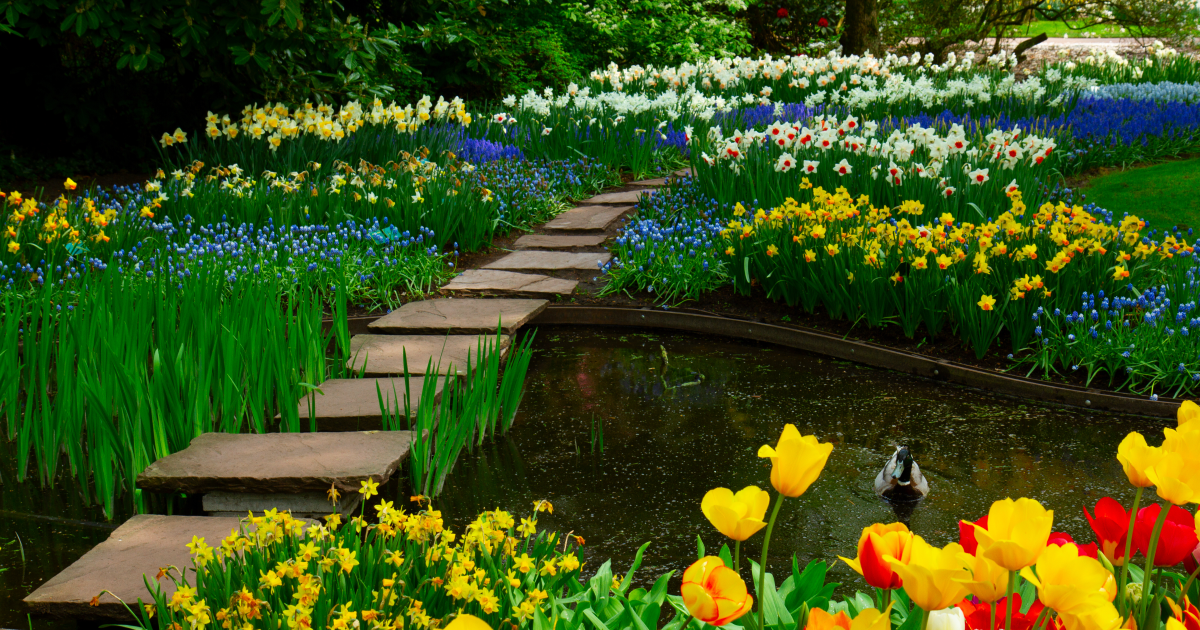How to Design a Spring Flower Garden

Spring is here! Why not seize the season by planting a spring flower garden?
If you’re new to gardening, don’t worry—planting a flower garden is easy and we’ll keep you grounded with this simple guide.
We’ve got the dirt on everything from growing zones to choosing flowers. At the end of this post you’ll have all the knowledge you need to start growing your garden today.
Ready to spring into action this spring? All you have to do is follow these five steps:
1. Find Your Growing Zone
Growing zones (also called Plant Hardiness Zones) tell you which plants will thrive in your garden. They take into account rainfall, humidity, temperature, and other factors that determine whether a plant will grow.
You can find your growing zone on the image below, or you can type your zip code into the USDA Growing Zone Map and it will tell you your zone.

2. Check Your Garden’s Sun Exposure
Different plants need different light levels, so it’s good to know how much sun your garden gets. Is it in full sun for most of the day? Are there areas dominated by shade?
Look out the window a few times throughout the day and make note of the light levels in the various parts of your garden. The three general categories are:
- Full sun. Direct sunlight throughout the day.
- Partial shade. A mix of sunlight and shade, depending on the hour.
- Full shade. Minimal sunlight throughout the day.
3. Draw a Garden Map
Sometimes it helps to see your garden laid out in front of you before you start planting.
Grab some paper and draw a map of your yard (our printable garden planner can help). Divide the yard into planting areas on your map, and make a note next to each area about how much light it receives.
4. Make a Flower List
Now comes the fun part: choosing your flowers.
Do a quick search online for plants that do well in your growing zone. For example, if you live in Charleston, South Carolina, zip code 29401, you’ll see that your growing zone is 9a.
A Google search for “growing zone 9a spring plants” reveals that daffodils, crocuses, violets, hibiscus, and hyacinths are all good choices for spring flowers.
Choose five or six plants that you like and that are suitable for your zone. As you search, be sure you also look up the ideal light condition for each plant and write it down.
You may also want to think about planting annuals versus perennials.
- Annual flowers only last for one season, so you have to replant them every year. This can be fun if you like getting creative with your garden each season—but it also means more upkeep and time spent gardening every spring.
- Perennial flowers grow year after year without any need to replant. A full perennial garden means less upkeep and yard work—but it’s also static, so your garden design won’t change unless you dig up your perennials, which can be hard on them.
A lot of gardeners combine annuals and perennials. You can introduce variety each year in the annual areas while the perennial areas take care of themselves.
At the end of the day, you’re the master of your garden. There’s no wrong answer here. Choose flowers that are right for you.
5. Plan Your Garden
Go through each planting area on your map and write the name of the flower you want to grow. You may also want to pencil in the color you want, to help you visualize your yard after planting.
Pro tip: a lot of veteran gardeners do color blocking, which is when you group similarly colored flowers together. For example, you may have a purple section, a yellow section, and so on. Color blocking is almost always visually appealing. It’s a great strategy if you aren’t sure which plants will look good together.
Pro tip #2: in addition to color, you may want to arrange plants by height and size. Put trees and large plants in the back, medium plants in the middle, and short plants at the very front. This adds visual depth to your garden. It also ensures that everything gets sunlight and allows you to see all your hard work.
Last pro tip: planting different textures near each other is a foolproof way to make your garden look good. It adds visual contrast and makes each individual element stand out. Consider placing smooth-leaved plants and flowers next to rough ones to create a pleasing landscape.
Once you have your garden map filled in, it’s time to get growing! Head to your local garden center (don’t forget to bring your map with you) and get all the seeds, bulbs, flowers, and mulch you need to start planting (if you’re looking for gardening tools we can help).
With your garden plan and your supplies, you’re ready to take on this year’s growing season. Happy planting—and if you want growing guides, expert gardening tips, special offers, and more, sign up for our email list below. We’ll help you keep your yard looking beautiful, all year long.





